Choosing the right email marketing platform is crucial for business owners looking to boost sales and engage with customers. Klaviyo and TinyEmail are two popular options but have key differences that business owners should understand before deciding between them.
In this in-depth Klaviyo vs TinyEmail comparison, we evaluate the two platforms across several categories to help you determine which solution best fits your business needs and goals. We will look at market position, ease of use, customization, features, website performance, customer support, pricing, reviews, and reputation.
Our criteria focus on the capabilities and metrics that matter most for delivering effective email marketing campaigns and driving growth to provide the details you need to choose an email marketing platform that aligns with your priorities and sets your business up for email success.
1. Understanding the Basics
Klaviyo was founded in 2012 by Andrew Bialecki and Ed Hallen, two entrepreneurs who wanted to create an intuitive, customizable email platform focused on e-commerce. Klaviyo is one of the most popular email service providers, currently used by over 90,000 businesses.
TinyEmail began in 2020, founded by Seamas Egan. It offers an easy-to-use email editor focused on small businesses and startups. TinyEmail has steadily grown in popularity but has a smaller market share than Klaviyo.
Both platforms have active online communities:
- Klaviyo Users Group on Facebook – 33,000+ members
- TinyEmail Community on Facebook – 1,100+ followers
While Klaviyo has a stronger market position, TinyEmail appeals to smaller businesses looking for an affordable, beginner-friendly option. Understanding your current needs and future goals will determine which solution may work best.
2. Features and Functionality
Automation
Klaviyo
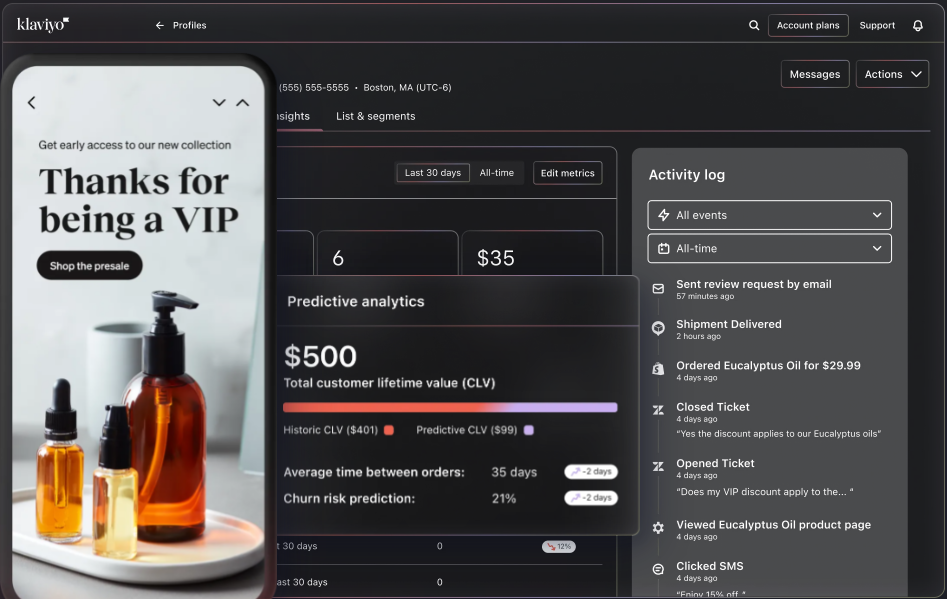
Klaviyo offers powerful automation tools to customize workflows. You can create segmented flows based on user actions, profiles, and other triggers. Use Kanban-style drag-and-drop editing to build sequences with email, SMS, and web push campaigns.
Flexible settings allow you to schedule sends in advance or base them on event triggers. For example, set up a welcome series for new subscribers, a re-engagement flow for inactive contacts, or a birthday promotion.
Klaviyo has robust segmentation options to target groups. Split campaigns based on location, purchase history, page views, and more. You can also segment with custom properties and integrations like Shopify.
Standout features include behavioral messaging to send emails based on how recipients interact with your site, and predictive modeling to automatically send each contact the message most likely to convert them.
Overall, Klaviyo provides enterprise-level automation with sophisticated options for e-commerce brands and high-volume senders.
TinyEmail

The TinyEmail builder simplifies setting up multi-email automations. Choose a trigger like “new contact” then build sequences with drag-and-drop. Content blocks help you easily insert repeat elements like headers and footers.
Options allow you to set delays between emails or skip based on criteria like email opens. You can also manually move contacts between sequences.
While easier to use than Klaviyo, TinyEmail has fewer advanced automation options. Segmentation is more limited for grouping contacts, especially compared to Klaviyo’s predictive modeling.
TinyEmail automations are better suited for basic, linear workflows. The platform lacks robust conditional logic or dynamic content insertion seen with Klaviyo. But it provides enough versatility for many small business automation needs.
Winner: Klaviyo
Both marketing automation tools offer powerful functionality for running successful campaigns. With its sophisticated tools for highly customized and targeted workflows, Klaviyo is the winner for email automation. The email marketing tool has segmentation, predictive modeling, and integration capabilities, which makes it a powerful choice as your business and campaigns scale.
Email Templates
Klaviyo
Klaviyo offers hundreds of professionally designed email templates to choose from. Browse by category like “Abandoned Cart” and “Welcome Series” to find relevant options.
The template editor makes it easy to customize fonts, colors, and layouts. Add images, text blocks, and buttons with drag-and-drop. Dynamic content tags pull in subscriber data.
Standout features include A/B testing email variants to determine optimal designs. You can also save customized templates to easily reuse high-performing layouts.
Klaviyo integrates with popular design tools like Sketch and Adobe Creative Cloud. Design-savvy users can craft custom mobile-responsive templates from scratch.
Overall, Klaviyo enables both the customization of templates and the design of new emails tailored to your brand.
TinyEmail
TinyEmail has about 30 free responsive email templates, as well as some for building landing pages. Options range from minimalist to visually heavy, covering common uses like promotions and newsletters.
The template editor is easy to use but less robust compared to Klaviyo’s. You can tweak fonts, colors, and text but have fewer controls over structural layout changes.
Saving customized templates is limited. While you can duplicate and edit existing templates, you can’t import completely custom HTML designs.
The template selection is sufficient for basic email needs but lacks more advanced options. Design capabilities are simpler for non-technical users compared to Klaviyo.
Winner: Klaviyo
With hundreds of professionally designed templates and powerful customization tools, Klaviyo offers superior email template options. TinyEmail provides a small but decent selection for basic email design needs, making Klaviyo clearly the best email marketing software in terms of design.
Segmentation
Klaviyo
Klaviyo enables advanced segmentation capabilities to target emails and campaigns. Options include demographic data like location, age, gender, purchase history, and lifetime value.
You can also segment by email metrics including opens, clicks, date subscribed, and email client. Furthermore, Klaviyo allows behavioral targeting based on actions like pages visited, links clicked, cart activity, and custom events.
It also uses predictive machine learning to group contacts likely to convert. Finally, custom properties from integrated apps like Shopify and CRM platforms allow advanced segmentation.
You can segment contacts using real-time or historical data. Multiple rules can be combined to create dynamic, nested groups for hyper-targeted messaging.
TinyEmail
TinyEmail has more basic segmentation tools for group contacts. The platform doesn’t offer unlimited custom segments, but you can segment by location to group subscribers by country. Email activity segmentation options include opens, clicks, and date subscribed. TinyEmail also allows manual interest group tagging or syncing groups from MailChimp.
While simpler to use than Klaviyo, TinyEmail’s segmentation options are more limited. It lacks robust behavioral or custom property segmentation abilities.
TinyEmail provides essential segmentation tools for smaller email programs but lacks enterprise-level targeting abilities.
Winner: Klaviyo
With its sophisticated options for demographic, behavioral, predictive, and custom segmentation, Klaviyo is the clear winner. TinyEmail offers simpler segmentation tools sufficient for basic email targeting.
Analytics
Klaviyo
Klaviyo provides powerful analytics tools to track email performance. View high-level campaign metrics like opens, clicks, and unsubscribes. Drill down to see data for individual emails and variants.
Tools like their Metric Explorer allow you to segment and filter data. Analyze metrics by location, device, browser, and more for in-depth analytics.
Standout features include the ability to track ROI from email to determine revenue driven. Klaviyo also provides statistics on how contacts flow through sequences and campaigns.
For technical users, the platform offers an API and custom reporting. Overall, Klaviyo enables deep analysis of email metrics beyond standard engagement tracking.
TinyEmail
TinyEmail has standard analytics covering opens, clicks, unsubscribes, and shares. Charts help visualize campaign performance over time.
Metrics can be filtered by date range or email type. However, segmentation options are limited compared to Klaviyo.
TinyEmail lacks more advanced analysis like multi-variant testing or revenue tracking. The platform focuses on simpler engagement metrics sufficient for most small business needs.
Winner: Klaviyo
With its advanced analytics offering advanced segmentation, custom reporting, and ROI tracking, Klaviyo wins for email analytics. TinyEmail provides standard metrics that cover the basics.
Unique Features
Klaviyo

Some unique capabilities Klaviyo provides include mobile push notifications and SMS marketing to design and send SMS campaigns alongside email and track performance. It also offers web push notifications to re-engage users through targeted browser pushes.
Klaviyo also has a subject line assistant which is an AI-powered tool to help you craft more effective subject lines.
Klaviyo has ratings and review tools to generate and display customer reviews to boost trust and sales. It also enables customized referral programs to acquire new contacts through existing customers. Finally, Klaviyo enables one-click surveys to gather first-party data from contacts.
These additional channels and tools maximize subscriber engagement beyond just email.
TinyEmail
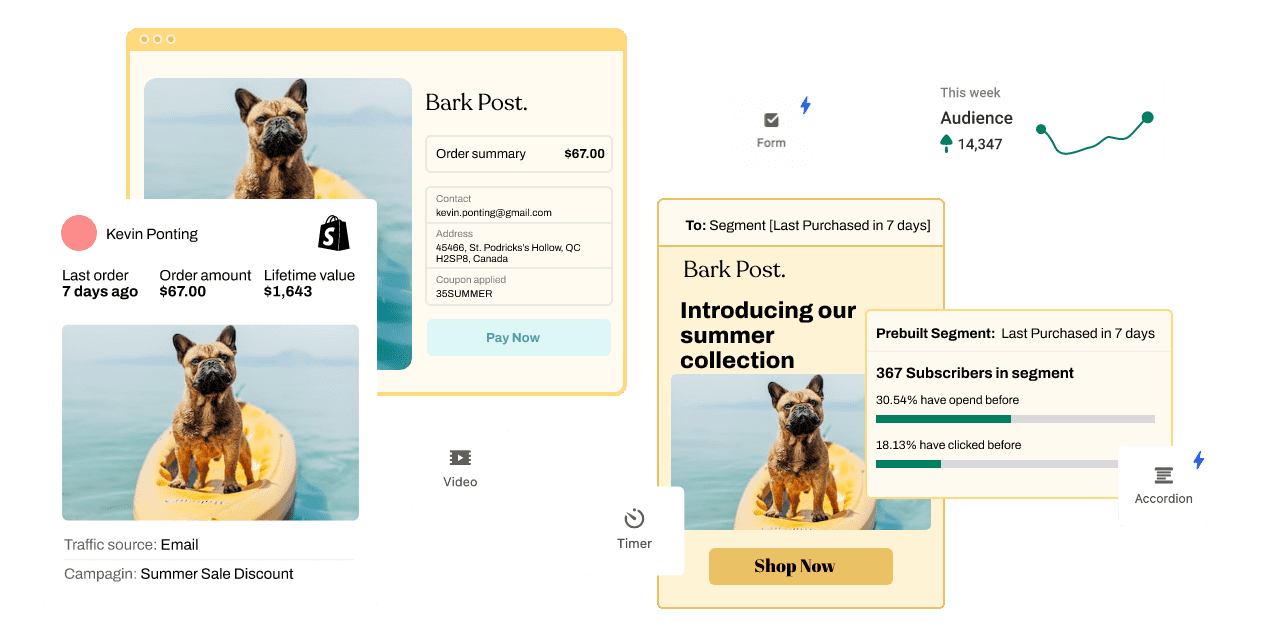
TinyEmail has a simpler feature set focused just on core email marketing needs. A couple of unique extras they offer include email parsing to automatically parse details like names, companies, and addresses from incoming emails.
TinyEmail also provides email tracking to see if recipients forward your emails and how many times emails are opened.
The platform lacks robust non-email features seen with Klaviyo. However, the core email capabilities meet most small business needs.
Winner: Klaviyo
Klaviyo wins for its wider variety of integrated marketing and subscriber engagement features beyond just email. For instance, the platform has a built-in AI subject line assistant. TinyEmail focuses more narrowly on essential tools for basic email campaigns.
3. Ease of Use
Klaviyo
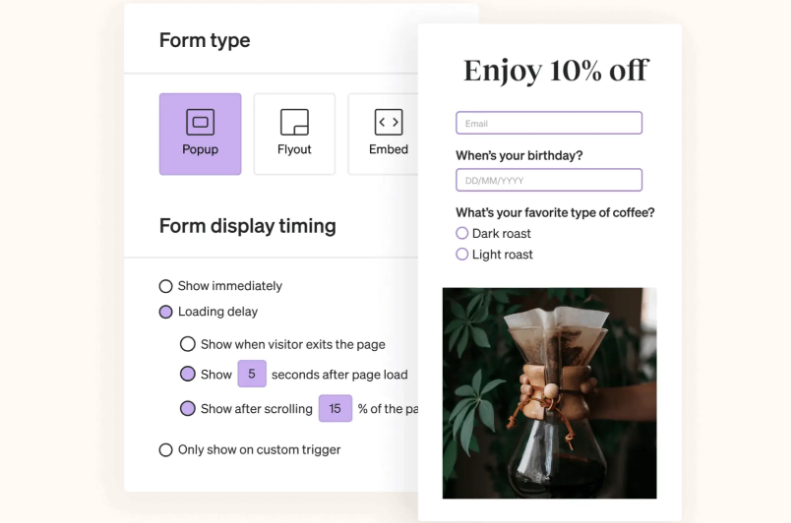
Klaviyo provides a modern, intuitive interface. The dashboard uses visual charts and summaries to provide campaign insights.
The email builder is easy to navigate with drag-and-drop tools and responsive previews. It may take beginners time to learn Klaviyo’s advanced features, but the platform makes automation and segmentation accessible.
Klaviyo offers thorough support docs and an active user community to aid the learning curve. The platform is feature-rich but designed to not overwhelm new users.
TinyEmail
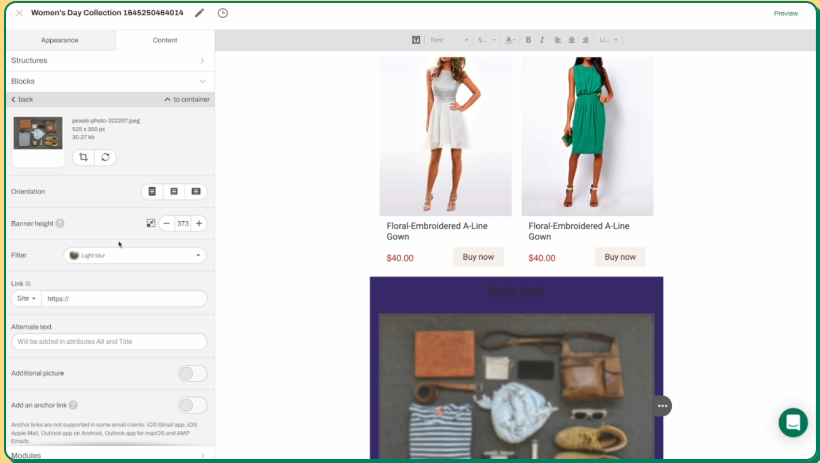
TinyEmail uses a simple, clutter-free design optimized for beginners. The pared-down interface makes core email functionality easy to access.
The drag-and-drop builder is very user-friendly. TinyEmail’s limited features also lower the initial learning curve for novices.
While Klaviyo provides more advanced options, TinyEmail’s simplicity reduces the barriers to entry. The minimal interface and education resources make it easy for non-technical users to get started.
Winner: TinyEmail
With its beginner-friendly design and interface focused only on essential email features, TinyEmail wins for overall ease of use. Klaviyo provides a well-designed platform but has a steeper learning curve.
4. Email Deliverability
Klaviyo
Klaviyo uses advanced deliverability features to optimize inbox placement. It provides dedicated IP addresses to protect the sender’s reputation. Automated warm-up routines ramp up new domains safely.
Klaviyo monitors bounce rates, spam complaints, and other metrics to identify deliverability issues. Tools like suppression lists prevent bad addresses from receiving emails.
For more technical users, Klaviyo offers SMTP relay options, custom DKIM keys, and custom DMARC settings for maximized deliverability.
TinyEmail
TinyEmail lacks some of Klaviyo’s enterprise-level deliverability controls. However, it does provide dedicated IPs and automated validation like SPF and DKIM.
The platform monitors standard spam test rates from major ISPs. Users can access deliverability reports to identify potential problems.
While TinyEmail covers email deliverability basics well, advanced users may want more custom controls compared to Klaviyo.
Winner: Klaviyo
With its dedicated deliverability tools like automated warm-ups, custom DKIM keys, and granular controls, Klaviyo offers superior email deliverability. TinyEmail provides good core protections but lacks capabilities for maximized inbox placement.
5. Customer Support and Community
Klaviyo
Klaviyo provides 24/7 live chat and email support. All users receive dedicated account management. Phone support is also available for upgraded plans.
The company offers an extensive knowledge base with articles, tutorials, and webinars. Klaviyo’s active online community exists via its Facebook group with over 33,000 members.
TinyEmail
TinyEmail provides email ticket support during US business hours. Phone or chat support is not offered.
The help center has a limited selection of articles and tutorials. For community support, TinyEmail users can connect with the brand on its Facebook page.
Winner: Klaviyo
With 24/7 live chat, robust educational resources, and a large user community, Klaviyo offers superior customer support and community options compared to TinyEmail.
Klaviyo’s investment in customer education and community fosters long-term user success better than TinyEmail’s simpler self-serve resources.
6. Integrations
Klaviyo
Klaviyo integrates with hundreds of marketing, e-commerce, and CRM platforms to help you manage customer data. Key integrations include Shopify to sync product catalogs, track purchases, and trigger automation.
It also integrates with Facebook to sync ad performance data and pixel events. Zapier integration connects countless web apps through its library of pre-built zaps. Klaviyo also integrates with Salesforce to sync subscriber and lead data.
Other notable integrations are with WooCommerce to import products and track shopping behavior, and Stripe to track payments and metrics. Klaviyo’s robust API also allows developers to build custom integrations.
TinyEmail
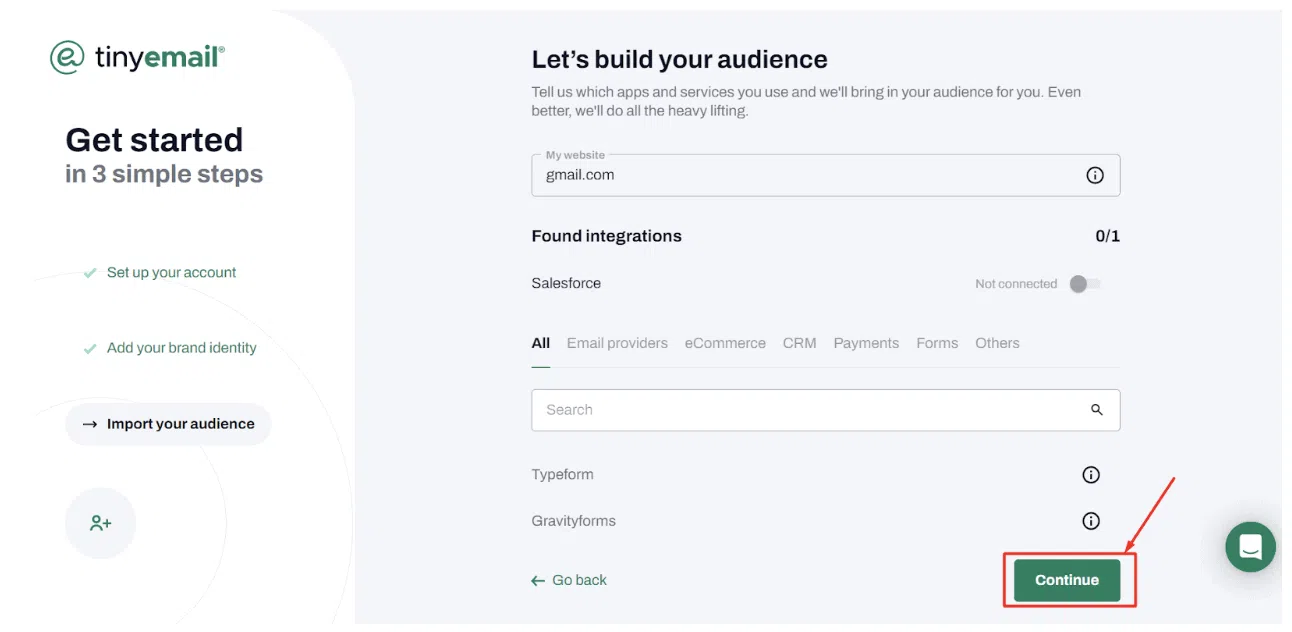
TinyEmail has over 50 native integrations including Shopify to import customers and sync cart data, Mailchimp to migrate lists and groups, Zapier to connect other apps through pre-built zaps, and Square to sync customer details with your POS. While TinyEmail covers key platforms, it lacks the breadth of integrations seen with Klaviyo.
Winner: Klaviyo
Both email marketing platforms offer third-party intergrations to help you run more successful and personalized marketing campaigns. With hundreds of integrations to platforms big and small, Klaviyo is the winner for third-party integrations. TinyEmail connects with major apps but cannot match Klaviyo’s extensive ecosystem.
7. Pricing
Klaviyo
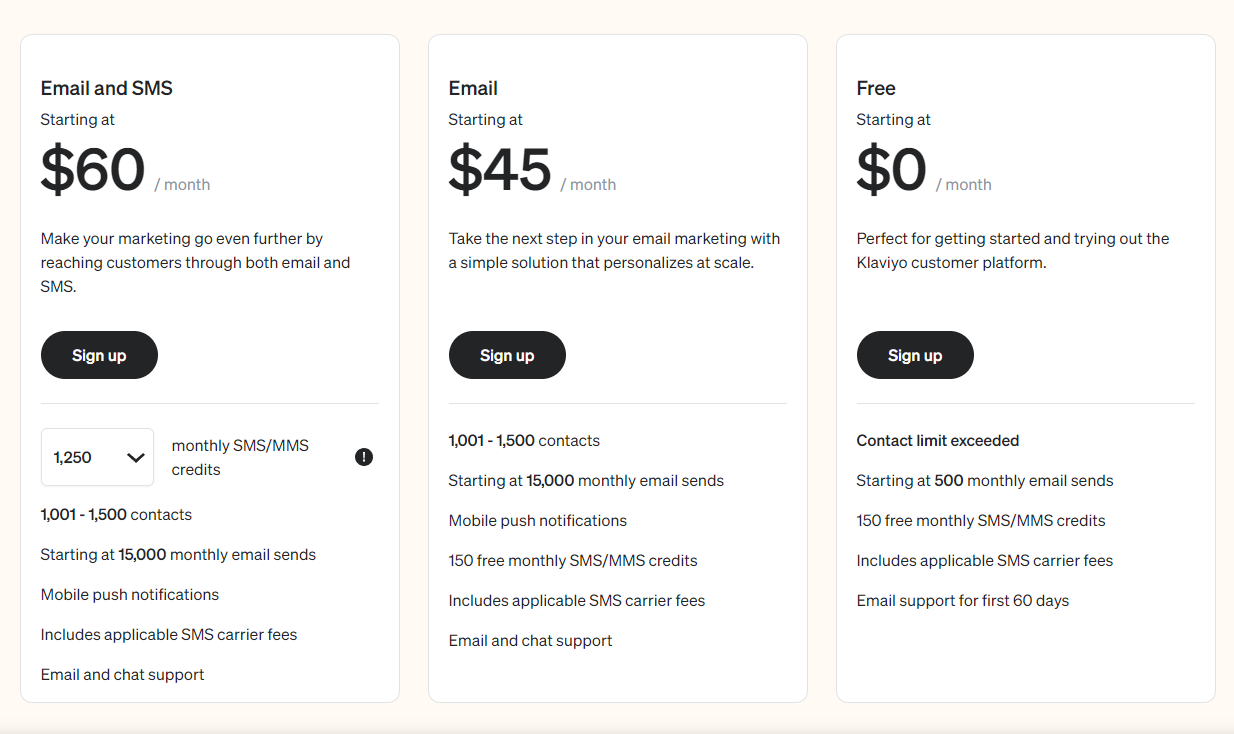
Klaviyo offers 4 paid plans:
- Free – Up to 500 monthly email sends, basic features
- Email – $45/month for up to 1,500 contacts and 15K email sends
- Email and SMS – $60/month to add advanced features like behavioral messaging
Klaviyo also charges based on emails sent once you exceed account thresholds. Overall pricing is competitive for the robust feature set but can get expensive at high volumes.
TinyEmail
Tinyemail offers 4 pricing tiers based on the number of emails you’ll send and the desired functionality.
Plans range from the free plan which has basic email marketing for up to 500 subscribers, to $65/month for the Pro plan which has unlimited subscribers and includes advanced features like A/B testing. Custom enterprise quotes are available.
Winner: Tie
Klaviyo offers advanced capabilities that justify its higher-tier pricing. But TinyEmail is a bargain for basic email marketing needs with no per-send costs. Each platform wins on pricing depending on an organization’s needs and size.
8. Reviews and Reputation
Klaviyo
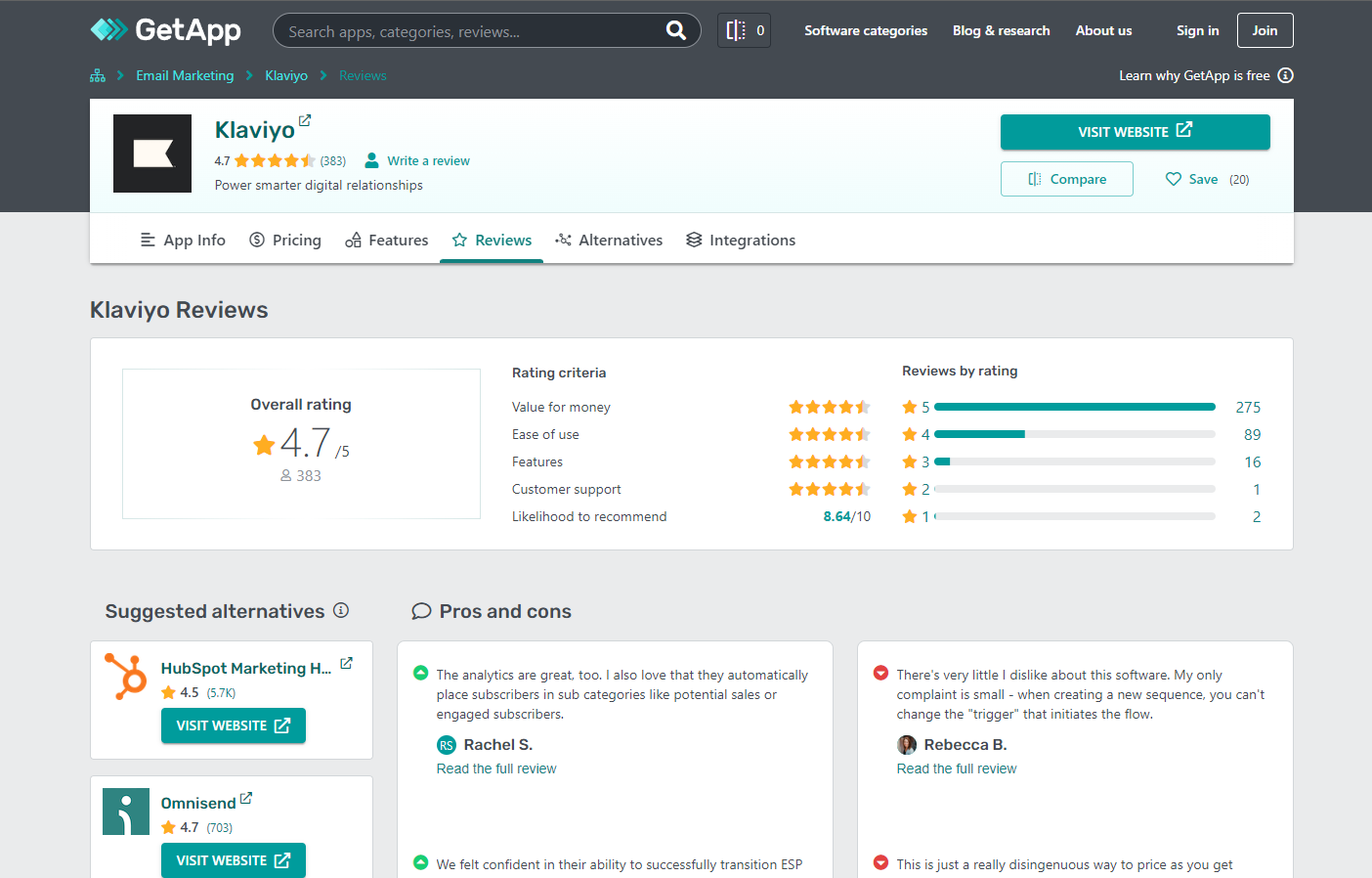
Klaviyo earns positive reviews for its powerful email marketing and automation capabilities designed to supercharge your email marketing efforts. Users praise the platform’s sophisticated segmentation, customizable workflows, and integration with e-commerce platforms like Shopify.
Some negatives cited include the steep learning curve for new users and high costs at higher volume tiers. But most reviews on sites like G2Crowd, Capterra, and GetApp rate Klaviyo highly.
TinyEmail
Users praise TinyEmail for its simplicity, ease of use, and affordable pricing. The platform earns kudos as a beginner-friendly email solution needing little technical skill.
Potential drawbacks mentioned include the smaller feature set compared to leading platforms. However, TinyEmail reviews on Trustpilot and other sites remain largely positive.
Winner: Klaviyo
Both email marketing tools have strong reviews online. However, with more users praising its advanced capabilities, Klaviyo edges out TinyEmail in reputation. But TinyEmail also maintains decent feedback as an entry-level email marketing platform with a focus on usability.
Klaviyo’s market-leading power comes at the cost of some complexity, while TinyEmail’s simplicity works for many basic email programs.
9. FAQ’s
Klaviyo FAQs
- What integrations does Klaviyo offer?
Klaviyo integrates with hundreds of platforms including e-commerce tools like Shopify, Facebook, CRMs, email services, and more. - Does Klaviyo have email templates?
Yes, Klaviyo offers hundreds of customizable email templates designed by professionals. Users can also create custom HTML templates. - Is Klaviyo easy to use?
Klaviyo provides a modern, intuitive interface. While advanced capabilities have a learning curve, core email functions are accessible to most users. - Does Klaviyo offer SMS marketing?
Yes, Klaviyo lets you design SMS campaigns tied to your email marketing workflows. - How much does Klaviyo cost?
Pricing starts at $45/month for up to 1,500 contacts. Enterprise plans are customized. Additional fees apply for high email volumes.
TinyEmail FAQs
- What’s the maximum number of contacts on TinyEmail?
The Unlimited plan supports unlimited contacts and emails. Lower tiers have limits of up to 2,500 contacts. - Does TinyEmail integrate with Shopify?
Yes, TinyEmail offers direct Shopify integration to import customers and sync data. - Is TinyEmail easy to use?
With its simple interface focused on core email features, TinyEmail is designed for beginners. - Does TinyEmail have email templates?
TinyEmail provides around 30 professionally designed, customizable email templates. - How much does TinyEmail cost?
Pricing starts at free for up to 500 contacts. Unlimited plans are $15/month with no per-email fees.
Final Thoughts
Choose Klaviyo if…
With its sophisticated segmentation and automation powered by deep analytics, Klaviyo is ideal for e-commerce brands looking to scale.
If you need advanced customization and metrics to create targeted workflows and maximize revenue, Klaviyo has the enterprise-level capabilities required. The platform is a robust long-term solution for high-volume marketers.
If Klaviyo isn’t for you, maybe some of these Klaviyo alternatives can be a great option.
Choose TinyEmail if…
If you’re a small business looking for an easy-to-use email marketing platform at an affordable price, TinyEmail is a great solution.
The simple interface, pre-built templates, and essential analytics provide everything you need for basic email newsletters, promotions, and automation without the advanced complexity. TinyEmail makes it easy to get started with email marketing quickly.
If you aren’t sure if TinyEmail is right for you, consider reading my favorite TinyEmail Alternatives.
Choosing the right email marketing platform is critical, so make sure to select the solution that best fits your business needs and goals. Feel free to ask any questions in the comments if you need help determining what’s right for your organization!
